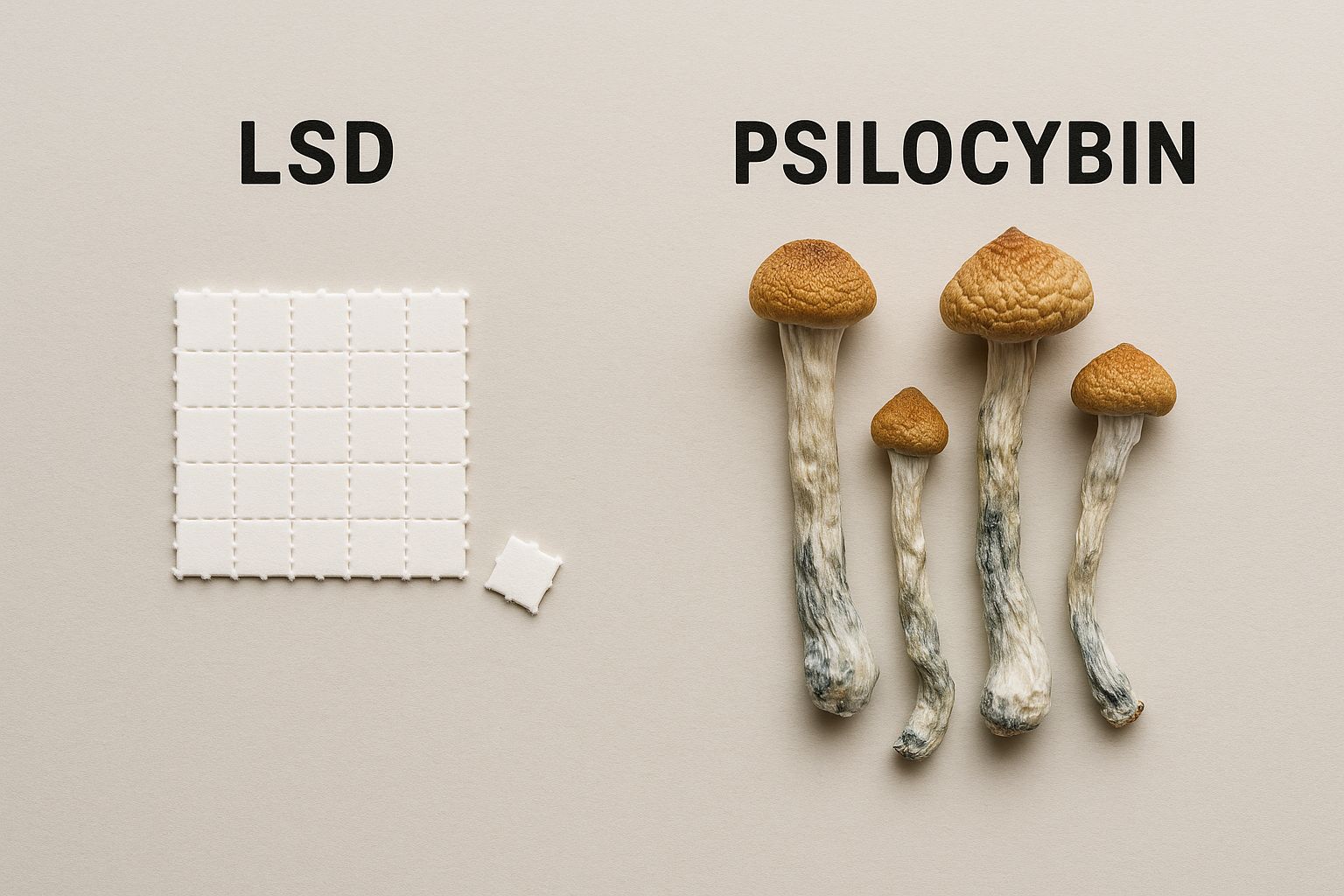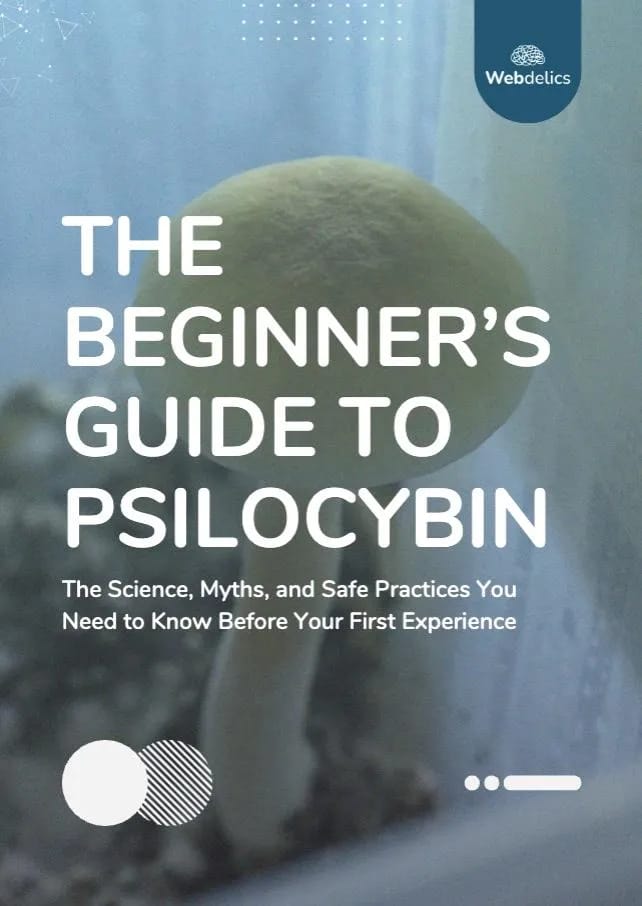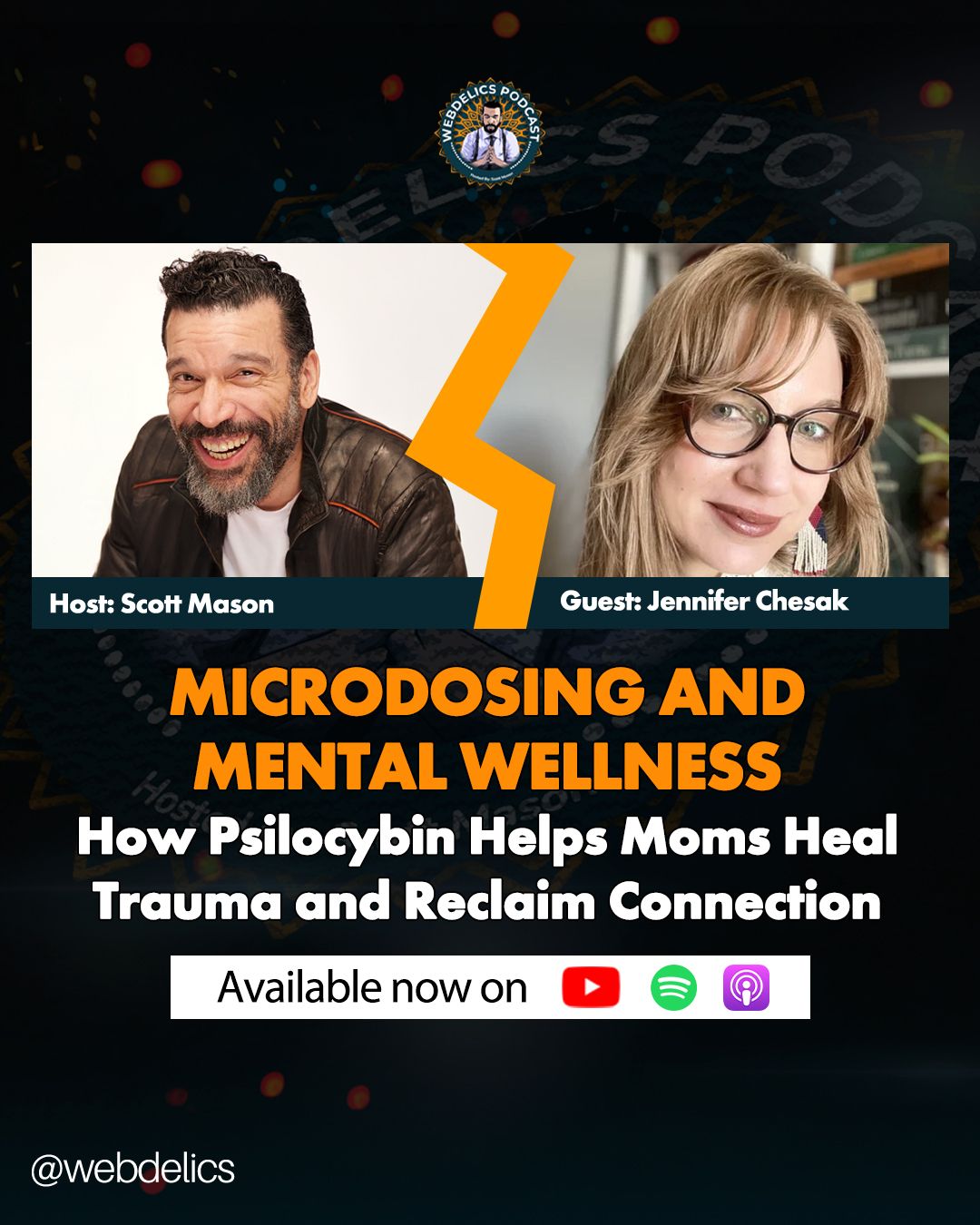- The Guide
- Posts
- 🧠 🔬 LSD vs Mushrooms - The Similarities and Differences Between Them
🧠 🔬 LSD vs Mushrooms - The Similarities and Differences Between Them
Not all psychedelics are created equally, here's why...


Explore the World of Plant Medicine and Psychedelics. A Weekly Digest of Exclusive Stories, Insights, and Research.

Welcome to this week’s edition of The Guide ⚡️
Today’s newsletter takes about 5 minutes to read—so if you’ve only got 60 seconds, here’s what you need to know:
LSD and mushrooms are in the same “family”, but have distinct psychedelic profiles. LSD (“acid”) and psilocybin mushrooms (“shrooms”) are both classical psychedelics that primarily act on the brain’s 5-HT2A serotonin receptors (a pathway tied to perception and cognitive flexibility).
Therapeutic momentum diverges between the two. Psilocybin currently leads with randomized trials for major depression and related conditions. LSD is re-emerging in studies, especially around anxiety, with encouraging but comparatively smaller datasets.
Context drives mental health and clinical outcomes. Benefits depend on careful screening, thoughtful set and setting, and structured integration. The data says that these factors often matter more than substance choice.
Law and access to these molecules is uneven. Several U.S. jurisdictions are piloting or regulating psilocybin service models, while LSD remains federally restricted. Always check local regulations and employment policies to understand accessibility.
🤞 Education and clinical studies both provide insights into the similarities and differences between these two psychedelics, so the more you know the better off you’ll be.
Let’s dive into it…
🧠 The Webdelics Team
👋 New here? We do this every week… Join Us!

🍄 Download Your Free Beginners Guide to Psilocybin

Curious about psilocybin but not sure where to start? Our Beginner’s Guide to Psilocybin breaks down the essentials - what it is, how it works, and why it sgaining attention in wellness and plant medicine.
Written in clear, accessible language, this guide is designed to help you explore safely and with confidence.
Download now for free and take the first step in your psilocybin journey.

🎧️ The Webdelics Podcast

🎙️ In this week’s episode of The Webdelics Podcast, we sit down with journalist and author Jennifer Chesak to explore how motherhood intersects with psychedelic healing and how to approach this intimate intersection with care, intention, and support.
This conversation reframes psychedelics as a coveted tool within a broader self-care practice for caregivers, specifically spotlighting preparation, consent, and integration as the bridge between meaningful insights and sustainable changes seen at home.
🔓️ Jennifer’s experiences and reporting helped us unpack pivotal insights like:
The science vs. stigma around psilocybin and microdosing psychedelics…
Why evidence, set/setting, and timing matters, especially for moms and caretakers…
How to navigate real-world pressures (careers, household labor, perimenopause, aging parents) while honoring safety, consent, and personal agency…
Practical ways to prepare and integrate, performing proper screening for contraindications, building support systems, and choosing intentional contexts over casual use…
Breaking cycles of stress and generational trauma by fostering resilience, emotional regulation, and open family communication…
❤️🩹 This episode was packed with a ton of great content and information that is relevant to everyone who has a beating heart, an open mind, and a focus for living their life to the fullest.

📜 Top Article
🔬 LSD vs Mushrooms - The Similarities and Differences Between Them
Disclaimer: This article is for educational and informational purposes only. Psychedelics remain illegal under U.S. federal law and in many places worldwide. This is not medical or legal advice. Always check local laws and consult qualified medical professionals before making any decisions about starting a new program.
As psychedelics continue to remain in mainstream conversations around mental health therapy, innovative brain-based treatments, and longevity, there’s a lot of confusion around understanding which psychedelics people shoulder take and use…
And while there are over 300+ know psychedelic species of plants and fungi, two psychedelics continue to remain in the spotlight:
LSD (“acid”) and psilocybin mushrooms (“shrooms”).
Both can generate shifts in reality and cause significant changes in perspectives when consumed, but many would argue that they’re not interchangeable…
This week, we’re breaking down the key similarities and differences between these psychedelics so you can separate the signal from noise and understand if/how/when they should or shouldn’t be considered.
📜 The History & Background of LSD and Mushrooms
LSD 🧪
Lab-synthesized (1938), usually placed onto blotter/gel tabs for consumption
Active at microgram levels; has a long cultural history in creativity and therapy research
Schedule I in the U.S., with new clinical trials for mood and anxiety disorders underway
Psilocybin Mushrooms 🍄
200+ species contain psilocybin (which is actively converted to psilocin in the body)
Consumed as dried whole mushrooms, capsules, or synthetic psilocybin (in trials, to standardize dose)
Also Schedule I, but FDA has granted Breakthrough Therapy status for depression
🔬 How They Work (Mechanism of Action)
Both are considered “classical psychedelics” that engage 5-HT2A (serotonin) receptors and transiently loosen one’s rigid “lines of thinking” by disrupting the brain’s default-mode network (DMN).
LSD additionally touches dopamine receptors (D2) and can affect additional 5-HT2B (serotonin) sites, which is why researchers think it can plateau longer in duration and its effects.
Psilocybin (psilocin) clears faster, shaping a shorter overall arc and duration of experience compared to LSD.
⏱️ Experience & Duration
• Onset - LSD ~30–60 min | Shrooms ~20–40 min
• Peak - LSD ~2–4 h | Shrooms ~1–2 h
• Total - LSD 8–12 h | Shrooms 4–6 h
Lab comparisons suggest ~100 µg LSD ≈ 20 mg psilocybin in peak intensity, with LSD simply lasting longer.
Many describe LSD as more “electric/analytical” and shrooms as more “earthy/introspective”, but set, setting, and dose drive most of the variability.
🩺 Therapy, Research & Clinical Trials
Depression & anxiety
Multiple randomized trials show psilocybin can produce rapid and durable relief, with effects lasting up to 6 weeks after 1–2 supported sessions.
LSD-assisted therapy also shows meaningful reductions in depression/anxiety vs. low-dose controls in recent Phase II clinical trials.
🏥 Other Clinical and Medical Indications
Early signals for alcohol/tobacco cessation, cluster headaches, and existential distress exist for both psychedelics…
Psilocybin currently leads in total publications and regulatory momentum, but LSD (and other psychedelics & plant medicines) are quickly catching.
⚠️ Risks & Considerations
Psychological Distress (“bad trips”) 🌪️
More likely at higher doses or poor settings, especially without supervision or
Physiological Effects 🫀
LSD can potentially cause transient increases in HR & BP
Shrooms can potentially cause nausea and GI disturbances
Interactions & Medication Side Effects 💊
SSRIs may blunt the effects of both molecules
It’s best to avoid MAOIs
Take extra caution with lithium
Contraindications 🛑
Personal/family psychosis, uncontrolled cardiac disease, pregnancy.
HPPD/Flashbacks 📸
Documented in case studies, but uncommon overall according to the literature.
⁉️ Are Psychedelics The Right Choice For You?
While we can’t answer that question, we can give you the information and education to discuss it with your medical providers.
As you can see, LSD and mushrooms are often put together in “same family”, but they have distinct and very different personalities…
Both primarily act on 5-HT2A, but LSD lasts longer and often feels more “analytical”, while mushrooms tend to feel more somatic and emotional.
Psilocybin currently leads in depression research, but LSD is quickly catching up.
And if you choose to pursue one or the other, know that context and integration are non-negotiable for both… Set and setting will always play a significant role in the outcomes of your healing journey.
👉️ Subscribe to The Guide for evidence-based takes on psychedelics, research, and integration tools—delivered weekly to your inbox.

💬 Come Join Us…
We don’t know what the future holds… But we do know we’re excited to be part of it.
At Webdelics, our goal is to translate current psychedelic and plant research into plain language so you can ask better questions, understand risks, and choose supportive practices, both legally and responsibly.
We appreciate you joining us along this journey!
Stay grounded. Stay informed. Stay epic.
🧠 The Guide - by Webdelics
Disclaimer: Webdelics does not support or promote any illegal activities, including the use of substances that may be mentioned in this newsletter. We encourage all readers to familiarize themselves with and adhere to the laws in their region. Please note that Webdelics does not offer mental health, medical, or clinical services and should not be used as a replacement for professional medical, psychological, or psychiatric care, diagnosis, or treatment.

How did you like today's newsletter? |